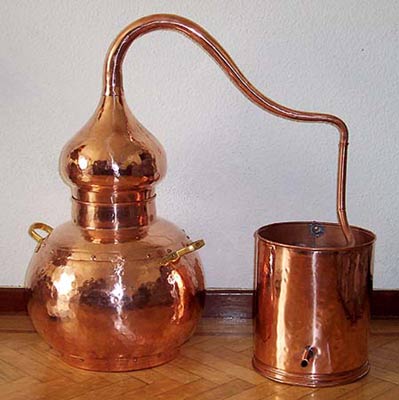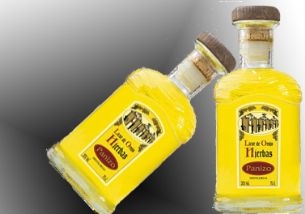
Origin: North of Spain- Castilla y León, Galicia, Asturias

Licor de orujo, or marc liqueur is originally from Spain, though it's related to other distilled spirits found throughout the Mediterranean region, such as the Italian grappa, the French marc, or the tsiroupo from Greece.
Licor de orujo is obtained from the distillation of grape marcs, that is, the solid parts of the grape after the fruit has been tread on or pressed, basically the skin that ferments. This shows the ingenious of the Spanish - producing something from what is essentially a waste product.
Alcohol distillation has its origins in ancient Greece and Alexandria. The latter was the cultural axis of the Mediterranean for a short period during the 2nd and 3rd centuries. As the Arab culture developed in later centuries, alchemy blended knowledge from other cultures and applied it to the distillation of alcohol, in fact, alcohol is an Arabic word. It was in fact the Moors who brought the technology to Spain, hence giving rise to many Spanish liquors and spirits such as licor de orujo, among many others.
Since the beginning, distillates have been given medicinal and miraculous properties. However only in 1663 appeared a reference to the stills used for the distillation of orujo. The German Jesuit monk Atanasio Kircher published a chemistry treaty in which he points out the marcs and wine residues to obtain orujo (marc) hard liquor.

However orujo hasn't had an easy history. Since the first orujos the government imposed hard tax rates and during the 19th century there was a ban on the elaboration and consumption of hard liquors and distilled beverages. Only in the beginning of the 20th century were some concessions made in regards to orujo distillation, however filled with obstacles.
During these times a limited number of experts would go from town to town, setting up stills. It was a home delivery service to produce licor de orujo from the grape harvest and wine production. The distilled product returned was equal to the amount of marc given, minus the percentage that the distiller took as commission.
Today things are different, and the production must be produced under completely legal frames. However their is a certain laxity to the clandestine production (which some consider as homemade).
Licor de orujo is mainly produced and consumed in the north of Spain, principally León, Asturias and Galicia, but if you happen to go abroad, in Spain, you can find Orujo in any bar and restaurant of the country.
There is a festival to celebrate the Spanish drink held every year on the second weekend in November in the town of Potes which is the capaital of Liébana in Cantabria. This festival started in 1991 and consists of several tasting of the orujo produced in the regopn, accompanied by traditional music and an old style market. The Orujo of Liébana is highly revered, and has been made in the region since the end of the Middle Ages. If you are a fan of your spirits, then you should definitely pay a visit to the festival if you get a chance.
In Galicia, they also use licor de orujo to produce a drink called Queimada. The main ingredients of this mixture are licor de orujo, sugar and some slices of lemon or orange, although some people also add coffee to it as well. The mixture is then set alight, and is only put out when the flames turn a bright blue colour. However this drink has become particularly popular due to the custom of reciting spell when making it. This has led people to believe that the drink was invented during the time of the Celts in Galicia, however this has been proved to be untrue - mainly because licor de orujo is a distilled drink, the technology for which only came about after the arrival of the Moors in the Iberian peninsular.
If you ever decide to spend some time in Spain, you must make sure that you try some licor de orujo. It is easy to find in bars and restaurants where it is commonly served as a shot after a meal. If you are feeling really brave, you could try making your own queimada too!